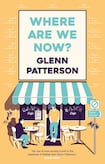
Herbie feels disconnected; he has lost his job, his marriage is over, his ex-wife has settled down with someone younger and new. “I have no idea who this person is,” he tells his doctor, “but it’s not me.” “The whole world is unlike itself,” his doctor says in response. “Lord help us, you hardly know when you go to bed whether you are going to wake up in the same country.”
Glenn Patterson’s 11th novel began in his head with the title Iterations because, he says, it’s one of the ugliest words he knows. What people used to call “versions” of things they now refer to as “iterations”. He wanted to explore the idea of how someone in middle age relates to the person who shared their name and some of their facial features in childhood. Are you the same person you were then or someone else entirely?
Ugly as it may be, iterations is an accurate word to describe this touching, nostalgic and funny novel about lost love, growing older and the realities of life in Belfast – a city still trying to recover from 30 years of violence that is ever-present and threatening.
I was lying tucked up in bed...thinking that we were this perfect unit, one of everything: mother, father, child. . . little heteronormative creature that I was
Like Belfast, with its “skyline of cranes and cloud-reflecting glass”, Herbie is trying to begin again. With time on his hands as never before, he helps a friend with a project by doing some research at the local records office, and this soon develops into a job of sorts. Along with the unexpected return from London of his adult daughter, Beth, whose future looks equally shaky, this provides Herbie with renewed energy and focus.
On the evening of Beth’s arrival, Herbie races to M&S to buy some ready meals and cheesecake. Keen to avoid wise-cracking Brian at the “10 items or less” till, he goes to the till furthest from there and is served by a woman he has never seen before, with prematurely white hair and a badge identifying her as Louise. A flirtation begins and swiftly becomes something more significant, causing Herbie to reflect on previous relationships, life’s fragility, illness and mortality.
Reflection and poignancy
The portrayal of Herbie and Beth’s father-daughter relationship is full of reflection and poignancy too. They spend their days talking, remembering, sifting through old photographs in shoe boxes, trying to make sense of the new world order. “I used to take such comfort when I was small”, Beth tells her dad, “nights I was lying tucked up in bed, or sitting in the back of the car listening to you and mum taking in the front – thinking that we were this perfect unit, one of everything: mother, father, child. . . little heteronormative creature that I was. I couldn’t imagine any of it changing, ever – and now look at us, literally all over the place.”
[Patterson] succeeds in creating a lively, colour-filled local population whose members also seem symbolic of decay, survival and renewal
Beyond the confines of Herbie’s home, a small, terraced house almost identical to the one he grew up in, he and Beth interact with a somewhat dizzying collection of local characters and bit-part players: Sam and Derek in the new cafe, Louise and Brian from M&S, Sean in the records office, Neeta from the soon-to-close post office, Audrey Bannon from up the road who lives with her blinds permanently tilted, as well as encroaching rats, three-legged dogs and perpetual, sinister seagulls. Patterson is brilliantly observant of the everyday and, rather than overwhelming or distracting, he succeeds in creating a lively, colour-filled local population whose members also seem symbolic of decay, survival and renewal.
There’s a strong sense of reflection and nostalgia throughout Where Are We Now? and of different versions of self: the new Belfast, with tourists taking selfies in front of murals; and the old one, epitomised by the man from the council, who Herbie loves to watch as he tends to the hanging baskets on the high street, in his “wellie boots, tan bib-and-brace dungarees, one strap perpetually undone, the woolly hat pushed back off his forehead, seemed to belong to another era, of lamplighters and knocker-uppers”.
The novel closes with a battle-weary but more buoyant Herbie: “Suddenly the game stretched out again before him, and six or five or even four hands seemed to hold out the possibility – probability – of at least one more change of fortune.”
Patterson, who has been a vivid chronicler of Northern Ireland over the past 30 years, writes with wit and lyricism and with such a profound sense of place that I found myself reading his words in a Northern accent. Glen Patterson, like Van Morrison, makes you nostalgic for a past you never had.












